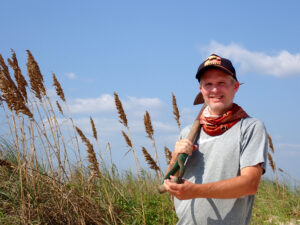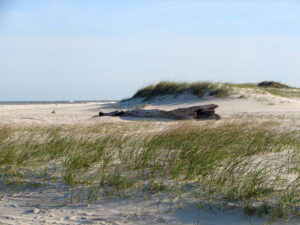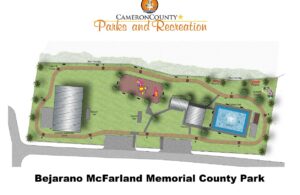- Fragile Planet Offers a Nighttime Wildlife Experience
- Falcons Soccer Off & Running
- Cameron County Receives Funds to Improve Two Parks
- Falcons Complete First Half of 32-6A
- School District to Help out Victims of California Wildfires
- Sand Castle Days Continued Despite Unexpected Weather
- Ready for District
- Discussion of Garbage Dumpster Rates, Agreements Between State & City on Highway Regulations, and More
- 31st Annual Shrimp Cook-Off is Right Around the Corner
- LFHS Cross Country
Sand Dunes, Vegetation Could Improve Sustainable Infrastructure
- Updated: July 7, 2023
Texas A&M AgriLife study provides insights for natural protective storm barriers along coastlines

Written by Adam Russell
Nature is helping scientists design better ways to protect people and property along coastlines from extreme weather events like hurricanes.
A team of scientists from Texas A&M AgriLife Research, the University of Delaware, Oregon State University, the University of Oxford, England, and the Universidad Nacional Autonoma de Mexico published an article, “Does vegetation accelerate coastal dune erosion during extreme events?” in Science Advances, that could change how structures to protect coastlines are constructed.
The study investigated how sand dunes and vegetation interact with heavy storm waves. Sand dunes block waves and decrease storm surges that flood homes, damage infrastructure and disrupt critical ecosystems. The research fundamentally alters the previous understanding of how natural and vegetative features can provide protection during extreme storm events.
Rusty Feagin, Ph.D., AgriLife Research professor and ecologist in the Department of Ecology and Conservation Biology in the College of Agricultural and Life Sciences, and adjunct faculty member of the Department of Ocean Engineering in the College of Engineering, both at Texas A&M University, Bryan-College Station, led the study.
Below, Feagin discusses the study, its significance in related scientific and engineering fields and how researchers simulated waves equivalent to Hurricane Sandy, which caused more than 100 deaths, over $60 billion in damages, and wrecked natural habitats along the East Coast in 2012.
Researchers conducted the simulation at Oregon State University’s O.H. Hinsdale Wave Research Laboratory, the largest wave tank in the U.S. The team used more than 100 truckloads of sand to create 15-foot sand dunes inside the wave tank, which is longer than a football field. Hundreds of native Panicum amrum plants were planted in the dunes and grown for six months before scientists battered them with waves.

Why is researching sand dunes important?
Hurricanes, tsunamis and other extreme wave events cause lots of erosion and property damage along coastlines. One way to mitigate the impact is to use natural solutions like sand dunes, wetlands and living oyster or coral reefs for protection. This research provides insight into what native vegetation does during an extreme event, which will help us design dune construction and restoration projects for protection.
What preparation and equipment was used to simulate waves produced by Hurricane Sandy?
We first measured and modeled nearshore buoy records that detailed the structure of the waves that hit sand dunes in Mantoloking, New Jersey, during Hurricane Sandy. We then programmed a computer to push a large paddle that generated the waves inside the wave tank to re-create those waves in an experimental context.
Were the findings something your team anticipated or a surprise revelation?
We were surprised, although we had already vaguely hypothesized that this sequence of events could occur. It is one thing to imagine that something is possible in a theoretical sense, in a little play “sand box” in your mind. It is an entirely different thing to put years of man-hours into building a massive sand box, and then see the phenomena happen in real life. You kind of feel lucky to have seen it, because it is really hard to design and create experiments to isolate the factor that you want to understand.
In this case, we had to go big to see the revelation. We had conducted many similar experiments over the prior decade in smaller wave tanks. By small, I mean on the order of a gigantic fish tank the size of a house. At that size, you can only simulate smaller waves and only over a few minutes before the sand is flying everywhere.
However, in this new experiment, we did what we had always dreamed – we had an even bigger fish tank, in this case about the length of a football field and with a 15-foot dune inside of it. At this size, you can simulate real-life tidal bores, over the course of an entire extreme event like Hurricane Sandy.
How did your findings differ from what was previously understood about dunes and beach features designed to mitigate storm damages?
We were surprised to see that during the extreme event, the vegetation actually accelerated the erosion. The plants created a porous barrier, which protected the dune in the landward direction, but re-directed and amplified the wave energy into the dune in the seaward direction. This patterning resulted in scour, which created a scarp, or a little cliff, on the dune face.
The vegetation also forced the entire volume of water into the sand at this location, which supersaturated and liquified the sand. Once the scarp formed and interrupted the formerly smooth dune slope, the erosion became locked into a feedback cycle where the waves, vegetation and sand continued to create a bigger and bigger scarp. The dune became locked into what we call the “collision regime,” where the waves just slam into the vertical scarp of sand and undercut it.
When that happens, the erosion happens really fast and the dune catastrophically falls apart. So, vegetation basically causes the dune to fall apart more quickly than it otherwise would.

What do you hope this study can do in terms of how we plan infrastructure to mitigate damage from storms like hurricanes?
We discovered that plants are good in the years before the extreme event, but bad during the actual extreme event itself. Thus, we want to select the plants and tools that maximize the growth of the dune in the years before the event and minimize the erosion during the event.
Vegetation, and other living materials and natural solutions, are tools that can help us to protect properties. But we’ve learned that we must use the right tool when and where it is applicable. “Hard” solutions like walls and rock jetties are also tools, but they can throw the hydrodynamics — the forces exerted by waves — out of equilibrium with the morphodynamics — the form and functions of the sand moving within the coastal system. So, you might reduce erosion in one spot but rapidly increase its severity in another. Plants and other natural materials provide a softer solution that can flex both ways in response to the changing hydrodynamic and morphodynamic conditions.
Our study showed that plants still act a bit like a hard solution during an actual extreme event. Importantly, however, plants and other natural materials help provide equilibrium on longer time scales, like over years. They help build the land by slowing the wind and accumulating sand and construct the sand dune to taller and taller heights. Thus, over years, the plants are very important because they build the dune in the first place.
Did the study data provide any recommendations for protective designs along U.S. beaches?
It did. It showed we want to grow native plants adapted to building the dunes most efficiently — not plants that look like they are big in physical structure or stiff and can protect against waves. For this reason, beach and dune managers should use plants such as sea oats or beach panic grass on the Gulf Coast, sea oats on the lower East Coast, American beach grass on the upper East Coast, and American Lyme grass on the West Coast. These native species will build the dune much better than other species and provide the best suitable habitat for animals like sea turtles, lizards, snakes, beach mice, beach rabbits and shorebirds. Additionally, once an extreme event hits, these flexible plant species will not precipitate the formation of a scarp as rapidly as dunes with non-native woody species like salt cedar or Australian pine or even old Christmas trees that are placed by well-meaning residents to reduce erosion.
In the end, we want plants that go with the flow rather than against the grain. We want the plants to build the dune before the storm, and then during the storm just lay back and stay in equilibrium, not try to resist.
What are some other benefits to restoring beaches and dunes using the method prescribed in this study?
Sand dunes enhance public and private property values. They provide an aesthetic appeal over ugly concrete seawalls, bulkheads or rocky barriers. They look natural, even if humans constructed or restored them. This improves the property value for homeowners. Moreover, people will visit a beach that looks natural and nice, over a small strip of sand next to an ugly seawall. A dune helps keep the beach natural-looking and wider for these visitors. Many coastal communities are dependent on tourism for their economic survival, and natural-looking dunes and beaches attract visitors.
Dunes also help divide the public beach from private land. In Texas, the “line of vegetation” demarcates where the public beach ends and private property starts. So, private landowners have an interest in pushing that vegetation seaward, and they will pay for people to restore dunes to do it.
As I mentioned earlier, dunes also provide critical habitat for many animals, including rare and threatened species. In Texas, for example, endangered Kemp’s ridley sea turtles lay their eggs at the foot of dunes.
How important is collaboration when it comes to a research study like this?
Without the help of many collaborators and technicians, it would be impossible to build a sand dune in a football field-sized wave tank. Personnel from at least 10 universities and several countries worked on this project. Several state and federal agencies contributed to the effort as well. The cost of this effort was millions of dollars.
Of course, when we design an effort on this scale, we do not design for only one outcome. So, stay tuned: We have additional research findings from this experiment that will come out soon. We are gaining a better understanding about the physics of sand particle movement during storms, how undertow currents work, and how we can create more resilient dunes.
What do you hope your research will ultimately contribute to how we prepare for catastrophic storms?
Our hope is that people can better manage coasts to meet the needs of both the natural world and humans.



